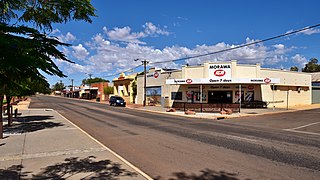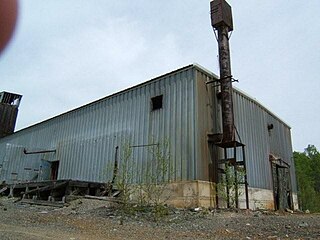
Ore is natural rock or sediment that contains one or more valuable minerals, typically containing metals, that can be mined, treated and sold at a profit. Ore is extracted from the earth through mining and treated or refined, often via smelting, to extract the valuable metals or minerals. The grade of ore refers to the concentration of the desired material it contains. The value of the metals or minerals a rock contains must be weighed against the cost of extraction to determine whether it is of sufficiently high grade to be worth mining, and is therefore considered an ore.

Limonite is an iron ore consisting of a mixture of hydrated iron(III) oxide-hydroxides in varying composition. The generic formula is frequently written as FeO(OH)·nH2O, although this is not entirely accurate as the ratio of oxide to hydroxide can vary quite widely. Limonite is one of the three principal iron ores, the others being hematite and magnetite, and has been mined for the production of iron since at least 2500 BP.

Coober Pedy is a town in northern South Australia, 846 km (526 mi) north of Adelaide on the Stuart Highway. The town is sometimes referred to as the "opal capital of the world" because of the quantity of precious opals that are mined there. Coober Pedy is renowned for its below-ground dwellings, called "dugouts", which are built in this fashion due to the scorching daytime heat.

BHP Group Limited is an Australian multinational mining, metals, natural gas petroleum public company that is headquartered in Melbourne, Victoria, Australia.

Morawa is a town in the Mid West region of Western Australia. It is located within the Shire of Morawa, approximately 370 kilometres (230 mi) north of the state capital Perth, on the railway line between Wongan Hills and Mullewa.

The Kanichee Mine, also less commonly known as the Ajax Mine, is an abandoned base metal and precious metal mine, located in the Temagami region of northeastern Ontario, Canada. It is near the small unincorporated community of Temagami North, accessed by the Kanichee Mine Road from Highway 11. The Kanichee Mine zone has been explored and mined discontinuously from as early as 1910. During the 20th century, it operated and closed down at least three times, with the most recent being from 1973 to 1976. To date, the discontinuous operation of Kanichee Mine has produced 4.2 million pounds of metal.

Mining in Papua New Guinea is an important part of the Papua New Guinea economy.
Allegiance Mining NL (ASX:AGM) is an Australian mining company listed on the Australian Securities Exchange on 29 October 1993.

Mining is the biggest contributor to Namibia's economy in terms of revenue. It accounts for 25% of the country's income. Its contribution to the gross domestic product is also very important and makes it one of the largest economic sectors of the country. Namibia produces diamonds, uranium, copper, magnesium, zinc, silver, gold, lead, semi-precious stones and industrial minerals. The majority of revenue comes from diamond mining. In 2014, Namibia was the fourth-largest exporter of non-fuel minerals in Africa.

The Gidgee Gold Mine is a gold mine in Western Australia, 82 km north of the town of Sandstone. The mine was, until recently, owned by APEX Minerals NL, but purchased by Panoramic Resources in February 2011. The mine is currently in care and maintenance and owned by Horizon Gold, having purchased the mine in 2016.

Iron ore mining in Western Australia, in the 2018–19 financial year, accounted for 54 percent of the total value of the state's resource production, with a value of A$78.2 billion. The overall value of the minerals and petroleum industry in Western Australia was A$145 billion in 2018-19, a 26 percent increase on the previous financial year.
The mining landscape in Zambia covers production of multiple mineral raw materials, including copper, cobalt, gold, nickel, manganese, emeralds, beryllium, myriad gemstones, sulfur, zinc, coal, iron ore, steel, limestone, uranium and other platinum-group metals. Mining has long been a significant primary sector industry and contributor to the Zambian economy by providing export income, royalty payments and employment.
Tyranna Resources is an Australian listed mineral exploration company. It was formed in 2015 by the merger of Ironclad Mining Limited and its major shareholder, Trafford Resources Limited.
The Wilcherry Hill Project was originally a proposed iron ore mine and associated infrastructure on Eyre Peninsula, South Australia. It was proposed by Ironclad Mining Ltd which later merged with Trafford Resources to become Tyranna Resources. As of 2018, the Wilcherry Project is a joint venture between Alliance Resources (67.35%) and Tyranna Resources (32.65%). The venture is exploring for economic concentrations of any of gold, tin, copper, zinc, lead, silver, iron, bismuth, tungsten and uranium.
WPG Resources was a mining company focusing on exploration, evaluation and development of gold and coal projects in South Australia.
The Braemar Alliance is a group of ASX-listed public and private mining and exploration companies with projects located in the Braemar region between Peterborough in South Australia and Broken Hill in neighboring New South Wales. The group was formed in 2011 with the intention of devising shared infrastructure solutions to provide water, power and freight corridors for the benefit of all members' projects. The Alliance's member companies have considered using existing outports and developing new ones on the eastern coast of Spencer Gulf to facilitate bulk exports, chiefly of iron ore. These include developing transshipping facilities at Port Pirie and building entirely new facilities at Myponie Point and south of Wallaroo. In July 2011, the Braemar Alliance had determined that its magnetite processing would require 50 gigalitres of water per year and that the water would be provided via a yet-to-be-constructed seawater desalination plant to be located on Spencer Gulf.
Selection Trust was a British mining finance house. It was started in 1913 by A. Chester Beatty, a mining engineer from the United States. After the end of the First World War, Beatty built up a substantial portfolio of mining interests, many of them in Africa, but others in Serbia and in Siberia. Initially the company began operations by sharing an office at Number One London Wall in the City of London with the consulting firm of Herbert Hoover, a fellow American mining engineer.
Cu-River Mining Pty. Ltd. is a privately-owned Australian resources company with interests in iron ore mining and port development projects in South Australia. It is the smaller of two iron ore exporters operating in the state, the larger being the GFG Alliance. The company is owned by Adelaide-based businessman, Yong Gang Shan and as of 2019 its only producing asset was the Cairn Hill mine in the state's Far North. The company has contracted mining, processing and freight logistics services to Agile Mining Services and Lucas Total Contract Solutions
Cairn Hill mine is an iron ore mine formerly operated by IMX Resources and now by Cu-River Mining. It is located 55 km south-east of Coober Pedy in South Australia and produced 1.8Mtpa of a unique coarse-grained magnetite-copper DSO product. The product was mined and crushed on site before being trucked and railed to Port Adelaide, where it was then shipped to China. Cairn Hill was a joint venture between IMX Resources (51%) and Sichuan Taifeng (49%).
Gordon Toll is a career mining industry professional and company director, with long term interests in iron ore mining and magnetite project development. In 2020 he was appointed non-executive director of Free Eyre Ltd and its subsidiary Peninsula Ports Pty Ltd, with the expectation of the company realising the Port Spencer project in South Australia ahead of the summer of 2020-21.









